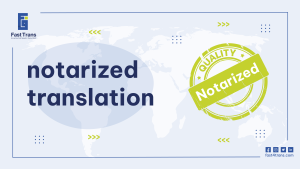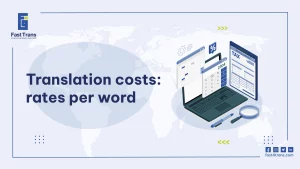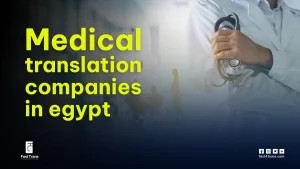A Translation Services RFP is a structured document that helps businesses find the perfect language service provider (LSP) for complex projects by outlining needs like languages, industry focus, and deadlines while inviting competitive bids. It ensures clear communication, enables comparisons of services, pricing, and quality, and fosters effective collaboration. By specifying requirements and evaluating vendor proposals with precision, businesses secure tailored solutions that align with their goals. Simplify your search by partnering with trusted providers like Fast Trans, known for exceptional localization, quality assurance, and seamless project execution across diverse industries.
What Is a Translation Services RFP?
RFP is short for ‘Request for Proposal’. It’s a tool-mostly a written document-utilized by businesses and corporations when they’re on the hunt for a suitable language service provider (LSP) or vendor to work on a big translation project. The thought process behind it is a simple one; an RFP states what linguistic services this business needs, and chooses the language service provider (LSP) that can best meet those needs.
Instead of spending lots of time searching for a language service provider (LSP), businesses that are about to work on a big linguistic project will call for language service provider or vendor proposals. It’s like a competition where vendors try to outstand other bidders.
Do you really need a Translation Services RFP?
When you are embarking on a big project, most probably, yes.
A request for proposal (RFP) is not just a great way to attract the best language service providers (LSPs) for your project, it also does the following:
- Allows for an interesting comparison between language service providers in terms of (provided services, resources, and prices)
- Communicates clearly the needs of your businesses to language service providers (LSPs) or vendors, which helps them meet your expectations without many back and forth on feedback
- Creates an environment for competitive bidding where language service providers (LSPs) try their best to market their capabilities and services.
- Enables businesses to stay within their budget, this is by stating clearly how much they are able to invest. Consequently, language service providers try to meet that in their proposal.
Read more: How to choose the right language service provider?
What Should You Include in a Translation RFP
There are 2 key points to be considered in a translation request for proposal RFP: offering information about your company and asking for information from the vendor.
The first section offers information about the company (the nature of the project, the company industry specialty, the needed language pairs, and the type of documents that need translation).
The second section requests information from the vendor like (pricing, company size, technological tools used in translation like TMS and CAT tools, previous client reviews, rate per word/hour, ISO certifications…etc)
Generally, the more clear and concise your request for proposal (RFP) is, the more you are helping the language service provider (LSP) decide whether they can be a good fit for the project.
Steps for creating an RFP
To craft a winning project proposal request, start by defining your project’s needs, challenges, and objectives while gathering relevant materials to share. Organize these insights into a clear, structured document outlining your company background, vendor requirements, and submission process. Research and invite qualified vendors, address their questions in a Q&A session, and evaluate submissions to choose the provider that aligns best with your goals.
1. Brainstorm the RFP
Before writing the request for proposal (RFP), some brainstorming and preparation has to take place. It’s where business owners or project managers find the answers to questions like (What are the requirements of this project? What are some weaknesses that can be improved?
Additionally, this step should involve gathering information and work samples that can shown to the potential language service providers. The more information there is, the more you allow the vendors to grasp the nature of your project.
2. Write the RFP
So far, you collected all the necessary information to be included in the request for proposal. Now it’s time to write them down in an organized document that’s easy to navigate.
The outline for the RFP:
- Company background (Name, specialization, and industry expertise).
- Details about the project (requirements that need to be met by the vendor).
- How selection works: this is related to the previous one. You can write in more depth how the selection of the vendor is done, what boxes do they need to check?
- How to submit the proposal (steps for vendors to follow in order to submit their project proposal).
3. Create a list of vendors
The request for proposal (RFP) is finally done, the next step is to get proposals from language service providers, but how do they know about your RFP?
You can find them either by getting recommendations from other clients who have dealt with translation service providers before, by contacting language service providers (LSPs) you previously worked with, or by gathering contact information of vendors in a directory.
After you research, gather these vendors in a list and send your invitations.
4. Q & A Session
Vendors and translation companies have been invited, and your request for proposal has been launched. However, there might be additional questions or inquiries that need to be addressed. Therefore, a meeting is scheduled that allows you to answer questions and clarify further on the RFP.
5. Evaluate Proposals & Make a Decision
Vendors have sent their proposals for your review. In this process you might need to contact them for work samples, or any further questions that will help you make the selection.
After that, the sound selection is based on how the vendor or LSP meets all your project requirements and criteria.
Questions for Translation Services RFP
When selecting a professional language solutions provider, ask about company size, location, project management, notable clients, and certifications like ISO 9001. Explore their use of translation and quality assurance tools, confidentiality protocols, pricing structure, and adherence to deadlines to ensure reliability and excellence.
1. Questions about the company
- What is the size of your company/agency?
- Where is it located?
- How are projects managed?
- Can you name me the top clients you had, and how was their feedback?
2. Company quality assurance
- What quality certification do you have? For example: ISO 9001.
- Can you guide me through authentic customer reviews
- What is the Translation management system do you use?
- Is there any quality assurance tool you depend on?
- What are your protocols for ensuring customer confidentiality?
- Can you send resumes or CVs to the project managers and translators who will work on the project?
3. Pricing
- What’s your rate per word/hour/page?
- Do you provide a free translation sample?
- What’s the pricing for project management?
4. Deadlines and working hours
- How do you ensure you always meet deadlines?
- Have you ever missed a deadline? If yes, why and how did you handle the delay with the client?
- What’s the availability of the translators and their working hours?
Translation Services RFP – Do’s and Don’ts
Crafting a clear and complete procurement request is key to efficient vendor communication, while critically assessing proposals and seeking client referrals ensures you find reliable language solution providers tailored to your needs.
1. Include all necessary information
You want to make sure that the RFP is thorough enough and includes all answers to all possible questions. Missing information in an RFP shows poor communication, and you will end up repeating yourself to the vendors in other to explain further what the RFP lacked, which can be time-consuming.
2. Be critical with your selection
A well-written proposal doesn’t necessarily mean they are the best fit. More importantly, a proposal is like an applicant’s cover letter, it’s all about making themselves appeal to the hiring manager, but it doesn’t act as proof that what they are saying is true. If you think a proposal is attractive enough, feel free to ask for work samples or demos to support their proposal.
3. Don’t underestimate word-of-mouth recommendations
When creating your invitation list, one way to get good recommendations for LSPs is through the word of mouth of satisfied previous clients, especially if they’re in the same industry as you. Such recommendations are a great way to know the pros and cons of a vendor from a party that doesn’t have a conflict of interest.
How to Request for Proposal Best Practices?
For a seamless translation service RFP, clearly outline project requirements, quality standards, and desired tools, emphasizing cultural adaptation and strict deadlines. Evaluate providers’ past work, cost transparency, legal compliance, and customer support to ensure alignment with your business goals and Fast Trans’ capabilities.
1. Clearly Define Your Requirements
- Specify the languages, document types, and subject areas (e.g., legal, medical, technical) that require translation.
- Include details about the expected volume of work and deadlines.
2. Include Quality Standards
- Request information about the provider’s quality assurance processes, including proofreading and editing.
- Ensure the use of certified and experienced translators.
3. Request Information on Tools and Technology
- Inquire about the use of translation memory tools, CAT tools, and glossaries for consistency and efficiency.
- Ensure data security and confidentiality measures are in place.
4. Ask for Samples or Case Studies
- Request examples of past projects, especially for similar industries or content types.
- Evaluate their ability to handle complex or high-volume projects.
5. Emphasize Localization Capabilities
- Ensure the provider can adapt translations culturally and contextually to target audiences.
6. Specify Turnaround Times
- Outline your required timelines and request details on the provider’s capacity to meet tight deadlines.
7. Budget Transparency
- Request a clear breakdown of costs, including additional fees for urgent or specialized services.
8. Evaluation of Customer Support
- Ensure the provider offers reliable support channels for ongoing communication and issue resolution.
9. Clarify Legal and Compliance Aspects
- Request information about adherence to local regulations, certifications, and non-disclosure agreements (NDAs).
10. Request Feedback Mechanisms
- Ensure there’s a system for reviewing and providing feedback on translations.
Following these best practices will help ensure a seamless RFP process and enable you to partner with a translation service provider like Fast Trans that aligns with your business needs.
What does a translation proposal look like?
A translation service proposal typically includes a compelling introduction highlighting the provider’s expertise, a customized pricing structure, a detailed overview of services to meet client objectives, a tailored translation methodology suited to the project’s nature, and a clear project timeline.
1. A cover letter:
A proposal will typically include a letter that explains why they are interested in working with you on the project, in addition to highlighting their biggest advantages that make them stand out.
2. Pricing:
the translation company or LSP will tailor pricing according to the project. The pricing section can involve things like (payment schedules, methods, and payment terms)
3. Scope of work:
it refers to the services involved in the project in order to meet the client’s goals.
4. Translation approach:
in this section, the translation company proposes its approach to the project. It might include several translation types like technical or financial. It’s good for clients to understand the different aspects of the project and how much effort each one will take.
5. Timeline:
this section includes their expectations of the project duration.
Do you Have a Translation Project? Contact Fast Trans now
Are you embarking on a challenging project and looking for a translation service provider to satisfy your business needs? Fast Trans is your go-to-choice especially if you don’t have the time to launch a meticulous RFP. Fast Trans prides itself as one of the leading translation companies in the MENA region, dealing with 20+ kinds of translation services in a variety of specialized fields like medical, financial, technical, and religious translation.
Contact our team to get a free quote, your journey with us starts here.
Conclusion
A Translation Services RFP is a formal document businesses use to find the ideal language service provider (LSP) for large-scale linguistic projects. It outlines the project’s needs—such as required languages, industry specifics, document types, and deadlines—while inviting competitive bids from vendors. This structured process allows businesses to compare LSPs on criteria like services, pricing, quality standards, and technological tools, ensuring that their choice aligns with their goals and budget. Clear RFPs also foster effective communication, reducing misunderstandings and enabling providers to deliver tailored solutions.
Creating an effective translation RFP involves several steps, including defining project requirements, outlining company details, and specifying vendor expectations, such as pricing structures, ISO certifications, and use of technology like translation memory tools. Competitive bidding is enhanced through clear instructions and by addressing vendor inquiries in Q&A sessions. Evaluating proposals based on work samples and adherence to outlined criteria ensures an optimal match. Businesses can simplify this process by partnering with experienced providers like Fast Trans, renowned for its localization expertise, quality standards, and reliable customer support across a broad spectrum of translation needs.











